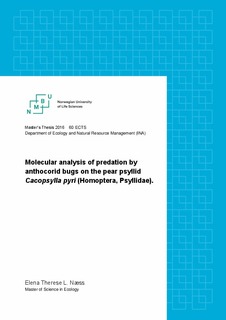| dc.contributor.advisor | Trandem, Nina | |
| dc.contributor.advisor | Hatteland, Bjørn Arild | |
| dc.contributor.author | Næss, Elena Therese Langeland | |
| dc.coverage.spatial | Norway | nb_NO |
| dc.date.accessioned | 2016-08-17T08:32:57Z | |
| dc.date.available | 2016-08-17T08:32:57Z | |
| dc.date.issued | 2016-08-17 | |
| dc.identifier.uri | http://hdl.handle.net/11250/2399467 | |
| dc.description.abstract | Understanding the trophic interactions between prey and its predators is vital for both population ecology and integrated pest management (IPM). In IPM, knowledge of how the trophic interactions in an ecosystem affect prey densities are exploited to improve pest management strategies. In Norwegian pear orchards, excessive use of non-specific pesticides has led the pear psyllid Cacopsylla pyri to become a major pest. Because of a renewed focus on pear production in Norway, alternative pest management strategies are needed. The predatory bugs Anthocoris nemorum and A. nemoralis are two of the most abundant predators in fruit orchards, and are considered a vital part of the natural control of pome fruit pest species. Both species are considered generalist predators, though A. nemoralis has been shown to prefer psyllids over other prey.
In order to assess the importance of A. nemorum and A. nemoralis as beneficial predators in Norwegian pear orchards, field samples were collected from a commercial pear orchard in Hardanger. Molecular gut-content analysis was performed in the laboratory to verify presence of prey DNA, using PCR including previously designed primers by Agustí et al. (2003b). To study the functional response of anthocorid bugs to C. pyri, the predation rate (defined as the proportion of psyllid-positive bugs) was compared to field prey densities. In addition, feeding studies were conducted in the laboratory to determine how long C. pyri DNA is detectable in the guts of A. nemorum and A. nemoralis under Norwegian field conditions.
The primer set Cp2F/Cp7R, reported to be specific for Cacopsylla pyricola and C. pyri, failed to amplify C. pyri DNA in this study. However, a second primer set, Cp3F/Cp6R, did successfully amplify all Psyllidae species tested, and showed no cross-amplification of nontarget organisms. Detection half-lives obtained in this study were much longer than expected, and possible reasons are discussed. Using the primer set Cp3F/Cp6R, a high predation rate on psyllids was detected, ranging from 82-92%, supporting the assumption that anthocorid bugs are important beneficial predators in fruit orchards. In addition, the relatively high number of anthocorids present in the field was surprising. C. pyri constituted 89% of prey available, indicating that C. pyri is an important part of A. nemorum and A. nemoralis diets. Thus, the results obtained in this study suggest the importance of generalist predators in pest control. Lastly, A. nemorum predation on psyllids was found to be negatively related to the presence of the ant Lasius niger. | nb_NO |
| dc.language.iso | eng | nb_NO |
| dc.publisher | Norwegian University of Life Sciences, Ås | |
| dc.subject | Cacopsylla pyri | nb_NO |
| dc.subject | Pear psyllid | nb_NO |
| dc.subject | Anthocorid bugs | nb_NO |
| dc.subject | Anthocoris nemorum | nb_NO |
| dc.subject | Anthocoris nemoralis | nb_NO |
| dc.subject | Entomology | nb_NO |
| dc.subject | Biological control | nb_NO |
| dc.subject | Integrated pest management | nb_NO |
| dc.subject | Gut-content analysis | nb_NO |
| dc.subject | Trophic interactions | nb_NO |
| dc.subject | PCR | nb_NO |
| dc.subject | Detection half-life | nb_NO |
| dc.title | Molecular analysis of predation by anthocorid bugs on the pear psyllid Cacopsylla pyri (Homoptera, Psyllidae). | nb_NO |
| dc.type | Master thesis | nb_NO |
| dc.subject.nsi | VDP::Agriculture and fishery disciplines: 900::Agriculture disciplines: 910::Plant breeding, horticulture, plant protection, plant pathology: 911 | nb_NO |
| dc.subject.nsi | VDP::Mathematics and natural science: 400::Zoology and botany: 480::Ecology: 488 | nb_NO |
| dc.subject.nsi | VDP::Mathematics and natural science: 400::Basic biosciences: 470::Molecular biology: 473 | nb_NO |
| dc.source.pagenumber | 39 | nb_NO |
| dc.relation.project | Norges forskningsråd: 245455 | nb_NO |
| dc.description.localcode | M-ECOL | nb_NO |
